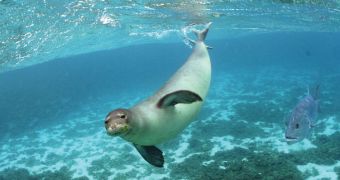While analyzing Hawaiian monk seal, a highly endangered species living in the Pacific Ocean, researchers were able to identify a potent and highly-debilitating toxin manifesting its effects inside the defenseless animals.
The discovery has prompted experts to start investigation other species for signs of the contamination as well. This is a first-of-its-kind finding, the team that conducted the new work reveals.
According to marine biologists, marine algae that live on coral reefs are primarily responsible for the production of the dangerous toxin, called ciguatoxin. The thing about this chemical is that it tends to accumulate inside fish species that are consumed by humans.
When people are exposed to high amounts of the toxin, they begin displaying a series of symptoms resembling those of chronic fatigue syndrome, which include neurological illness and acute gastrointestinal manifestations.
Thousands of people suffer from this condition, called ciguatera, every year. Apparently, so does a large portion of the 1,100-1,200 Hawaiian monk seal specimens still alive today. All of them are exposed to massive amounts of the dangerous chemical daily.
“Based upon this study, we believe that ciguatoxin exposure is common in the monk seal population,” explains study coauthor Charles Littnan. He is a scientist with the US National Oceanic and Atmospheric Administration's (NOAA) Pacific Islands Fisheries Science Center.
“This study is an important first step. However, we still need to understand more clearly how widespread exposure is and more importantly what role it may be playing in the decline of the species,” the investigator goes on to say.
The research effort was conducted by experts with the NOAA National Ocean Service (NOS), who worked together with colleagues from the NOAA National Marine Fisheries Service (NMFS).
Details of the work were published online by the American Chemical Society (ACS).
“The threat could pose management challenges for this species that has been dwindling at four percent annually due to poor foraging success and additional environmental and human factors,” a press release from NOAA states.

 14 DAY TRIAL //
14 DAY TRIAL //